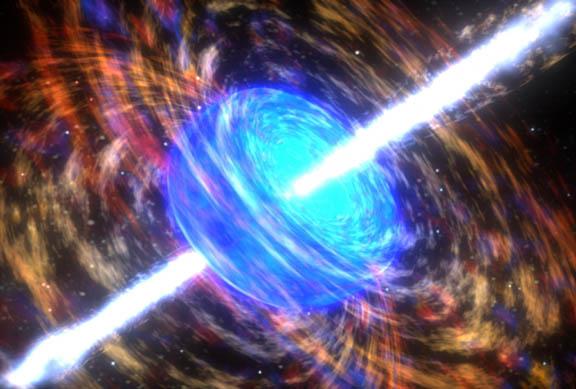The bursting sky
At a glance
- Transient events emit great energy over different time intervals, ranging from fractions of a second to a few years
- Millisecond bursts of radio waves, called fast radio bursts (FRBs), have only been detected at radio wavelengths so far, and their origin is unknown
- The SKA telescopes will use wide area sky surveys to discover these mysterious bursts, detecting more and fainter bursts than previously possible
Transient events are those that change in intensity with time, often unleashing great energy in a relatively short-lived event such as gamma-ray bursts or supernovae (stellar explosions). This is a fast-evolving and exciting area of radio astronomy.
The SKA telescopes will conduct surveys covering large areas of the radio sky from the southern hemisphere, mapping the cosmos while discovering new classes of object. Viewing a wide area of sky means they will more effectively capture transient events, which can easily be missed by a smaller field of view instrument. As the telescopes are so sensitive, they will also detect fainter transients than has been possible in the past, helping to greatly expand our knowledge about these events and the phenomena that cause them.
Known classes of transient range in time scales from less than a nanosecond (one billionth of a second) through to several years, which is still a short period of time in the cosmological scale of things. Sometimes these events are visible at multiple wavelengths across the electromagnetic spectrum, but one of the fastest-developing areas of transient science is so far unique to radio astronomy: fast radio bursts (FRBs).

Fast radio bursts: did you know?
- A millisecond duration FRB can emit as much energy as the Sun does in a whole day
- It is not yet clear where that energy comes from - we see the result, not the cause
- Despite being immensely energetic for radio objects, FRBs are not that energetic compared to other astronomical phenomena. They are dwarfed by gamma-ray bursts - the most violent events in the Universe - which release as much energy as the Sun does in its lifetime
Spotting more bursts to identify trends
Discovered in archive data from Australia's Parkes radio telescope in 2007, fast radio bursts (FRBs) are millisecond bursts of radio waves. So far, they have only been observed by radio telescopes, making them a key area of interest for SKA science. Detecting such fleeting events involves considerable signal processing and data management challenges, which the SKA telescopes are designed to meet.
It is thought that there is a bright FRB visible roughly every 10 seconds somewhere in the sky, but most telescopes can only view a fraction of the sky at any one time. SKA pathfinders and precursors that have been designed with wide fields of view include CHIME in Canada, MeerKAT in South Africa, ASKAP in Australia, and FAST in China, and have been at the forefront of FRB discoveries in recent years. In spite of the great progress that has been made, these strange flashes are still amongst the biggest mysteries in the Universe.
FRBs vary in brightness and while most appear to be one-off events, some have been found to repeat. Recent advances in data processing have meant that telescopes can now detect FRBs in realtime, rather than having to search through data archives, allowing for the possibility to alert other observatories for follow up observations. This is helping to advance the field at an amazing rate.
A leading theory is that these bursts emanate from highly magnetised neutron stars, which are very compact and pack a lot of energy into their small area, but astronomers cannot yet be sure.
The SKA telescopes will help in two key ways. Firstly, detecting more FRBs, and fainter ones which are much more numerous. Secondly, studying those we already know about in a much more detailed way than is possible at the moment. The more we can detect and study in a detailed way, the better chance we have of identifying trends that can lead to eventually cracking this mystery.




